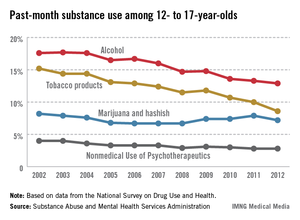Teens are drinking less, seem to be responding to messages to stay away from nonmedical use of prescription drugs, and are slightly curbing marijuana use. For adults, however, the story is slightly different. Marijuana use is increasing, especially in those aged 18 to 25, and overall illicit drug use is growing in the 50- to 64-year-old segment.
That’s according to the latest data from the annual National Survey on Drug Use and Health (NSDUH), which is sponsored by the Substance Abuse and Mental Health Services Administration (SAMHSA), and tracks the illicit use of substances in the U.S. population. The 2012 NSDUH report screened almost 70,000 people aged 12 and over between January through December 2012.
"These findings show that while we have made progress in preventing some aspects of substance abuse, we must redouble our efforts to reduce and eliminate all forms of it throughout our nation," said SAMHSA Administrator Pamela S. Hyde, in a statement.
Marijuana is by far the most popular illicit drug in America. Overall, 7% of survey respondents were current marijuana users in 2012. Past-month use rose in almost every age group from 2007 to 2012. A quarter of 18- to-20-year-olds and 17% of 21- to-25-year-olds were past-month users, and a third of each group had used in the past year.
Rates declined very slightly for 12- to-17-year olds, from 7.9% in 2011 to 7.2% in 2012. But the proportion who said smoking marijuana once or twice a week was risky decreased from 55% in 2007 to 44% in 2012. A similar slight decline in use, but a larger decline in perception of risk also was seen in the Monitoring the Future survey released in December, which is sponsored by the National Institute on Drug Abuse.
The decreased perception of harm is particularly dangerous, because it can lead to higher usage rates, said Dr. Sharon Levy, director of the Adolescent Substance Abuse Program at Children’s Hospital, Boston, in an interview. The edging up of marijuana use among older adolescents is likely attributable to an ever-present and growing national conversation that marijuana is safe, said Dr. Levy, who also serves as chair of the American Academy of Pediatrics’ Committee on Substance Abuse.
She said that while cannabinoids might end up being useful from a medical standpoint, marijuana itself is associated with harms in children and adolescents, including an increase in mental health disorders and decline in motivation, and potentially, a higher risk of cognitive decline.
The AAP’s most-recent statement on substance abuse intervention and treatment (Pediatrics 2011;128:e1330) recommends that clinicians start screening children for substance abuse at age 12 years. By that time, it’s likely that they’ve heard of marijuana, Dr. Levy said. Children expect health advice from their pediatrician; the aim is to keep the information both medically and personally relevant as much as possible, she said. Athletes can be told that smoking will affect their lungs, for instance.
More positively, the SAMHSA data showed a stabilization of nonmedical use of prescription drugs, such as narcotics, among young adults aged 18-25 years. In 2012, 5% of that age cohort admitted to past-month use, which was similar to rates in 2010 and 2011, but lower than the 6.4% reported in 2009.
Past-month drinking, binge drinking, and heavy drinking among adolescents aged 12-17 years also stabilized, and rates were lower than previous high points of 2002 and 2009.
About half of Americans over the age of 12 years say they are current drinkers. About a quarter in 2012 identified as binge drinkers, which is five or more drinks on one occasion at least 1 day in the past month. That’s the same rate as in 2011. Heavy drinking stayed the same also, for all age groups.
The declines in alcohol, tobacco, and nonmedical prescription drug use among children were encouraging, and indicate that government and physician-led efforts "are having an impact," Dr. Levy said.
"We’re never going to eliminate all use, but we can continue to push it down," Dr. Levy said.
R. Gil Kerlikowske, director of the Office of National Drug Control Policy, agreed that campaigns focusing on prescription drug use had had some effect. "For the first time in a decade, we are seeing real and significant reductions in the abuse of prescription drugs in America, proving that a more comprehensive response to our drug problem can make a real difference in making our nation healthier and safer," he said in a statement.



